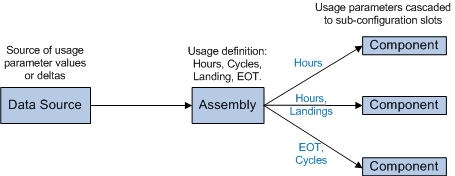Usage parameters and usage definitions
Usage parameters are used to track how long equipment has been in service, based on a specific usage unit of measurement, such as airframe hours and cycles. Usage values are usually associated with an event, for example a flight.
Usage parameters are most important for components that get damaged or worn out from use—those that can crack from stress, impact, or fatigue due to moving parts. Usage parameters can be recorded as absolute counts, or as incremental counts (such as one more aircraft landing).
Maintenix uses usage parameters to calculate the time between maintenance activities on the aircraft, and on its sub-components. For example, if an aircraft must be inspected every 100 hours of flying time, a usage parameter for flying hours is assigned to the assembly on which the aircraft is based.
Maintenix includes standard usage parameters, such as HOURS and CYCLES, and lets you define as many additional usage parameters as your organization requires. Usage parameters are stored in a global list, and they can be assigned to any assembly.
To specify the usage parameters to track, you create usage definitions for each assembly. Usage definitions are groups of usage parameters, and they are used to categorize usage parameters based on the source of the usage data. The following table describes the data sources and how usage values are entered and updated for each one:
| Data Source | Description |
|---|---|
| BULK (Bulk Usage Entry) | This data source is for specifying the usage parameters that users must be able to enter in Maintenix by creating a usage record or by editing an inventory's usage. It is also used for usage parameters whose values are sent to Maintenix via an integration with external systems. |
| EDIT (Allows edition of data collection) | This data source is for parameters for historical flights that personnel in the technical records department enter manually in the Maintenix interface. |
| MXFL (Maintenix Flight Log) | The source of the parameter values is either manual entry of the flight data in the Maintenix interface, or an external flight monitoring system that is integrated with Maintenix using the Maintenix Flight API. See the Maintenix Flight API Guide for more information about this type of integration. Note that only the parameters assigned to the MXFL data source are displayed to users when they create a flight record in Maintenix. |
Once a usage parameter is assigned to an assembly, you can assign that parameter to the various sub-configuration slots of the assembly, as required by the maintenance program. For example, if a component must be overhauled every 100 flying hours, the flying hours usage parameter is assigned to the sub-configuration slot to which the component is assigned.
By setting up the hierarchical structure of the assembly, you can assign usage parameters created for an assembly to any or all of its sub-assemblies and components to define the type of usage these sub-assemblies and components accrue, as illustrated in the following diagram. When the parent assembly accrues usage—for example when a flight occurs—Maintenix applies the usage collected on the aircraft to each component, based on the usage parameters specified for each configuration slot in the assembly baseline.
Figure: Usage parameters from top-level assembly to components

You can only cascade a parameter from the root of the assembly, which assigns the parameter to all configuration slots in the assembly hierarchy, or from any configuration slot, which assigns the parameter to all sub-configuration slots that are below the configuration slot. You can also manually assign any of the parameters in the assembly's usage definition to a specific configuration slot.
The usage parameters that are assigned to each assembly, sub-assembly, and component, should all be defined during the set-up of the aircraft in Maintenix and before flights (with usages) are recorded against the aircraft. This is typical practice and best practice.
The usage values are recorded against the assembly on which the sub-assemblies and components are installed. The number and order of MXFL usage definition parameters displayed on various pages is configurable. For more information see the Maintenix Administration Guide.
If a sub-assembly can accrue usage while it is not installed on the parent assembly, for example an engine can accumulate usage as the result of a bench test—and it has maintenance requirements that are scheduled based on usage—you want that sub-assembly to have its usage values even when it is removed from a parent assembly. In such cases, you must create a usage definition on the sub-assembly itself, and assign it the correct usage parameters. When the sub-assembly is installed on a parent assembly, Maintenix tracks any additional usage parameters that come from the usage definition of the parent assembly, and that are assigned to the configuration slot where the sub-assembly is installed.
Forecast models let you define rates at which an aircraft, and any component that is installed on that aircraft, will accrue usage for a certain period of time. Maintenix uses these rates to predict the usage-based maintenance deadlines.